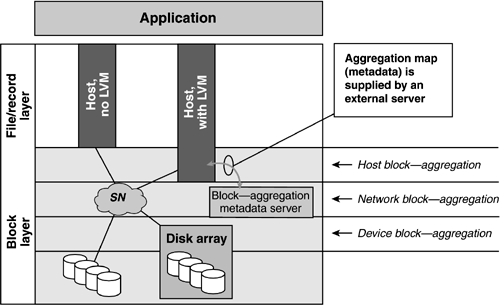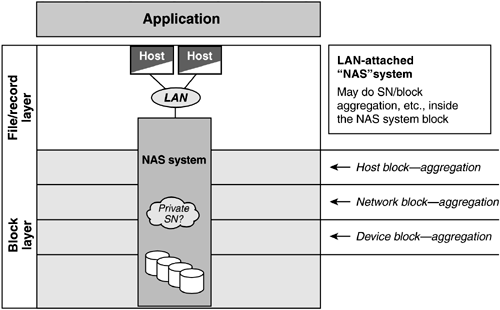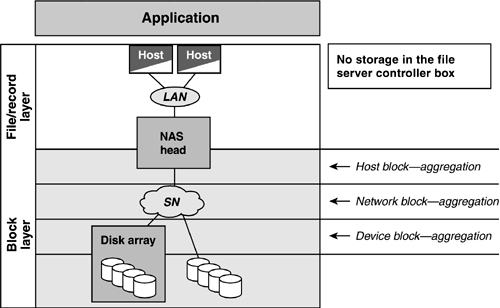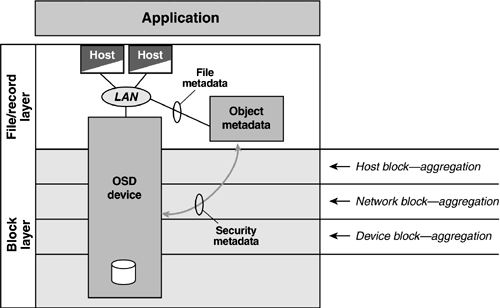Block storage aggregation in a storage network ( SAN appliance )
Block storage aggregation in a storage network ("SAN appliance")Block storage aggregation in a SAN appliance is characterized by:
This is a convenient option for centralizing the control over data placement in a shared storage environment: only the SAN appliance has to be updated to change where data is placed on the back-end storage devices. It comes at the cost of adding an additional step to the data-path, and runs the risk of the SAN appliance being a performance and availability bottleneck. Figure E-19.
The SAN appliance may provide some of the redundancy functions that are normally associated with disk array controllers, or it may simply provide the space management functions of block aggregation. Storage network-attached block storage with metadata server ("asymmetric block service")Storage network-attached block storage with metadata server is characterized by
By comparison to the "SAN appliance" architecture, this does not impose additional physical resources in the data-access path, but data placement changes require coherent updates of any cached copies of the metadata (layout information) held at the hosts. Figure E-20.
Multi-site block storageMulti-site block storage is characterized by the use of peer-to-peer protocols between like components of two or more systems at different sites to maintain data replicas at each site. This addresses the increasing need for geographic separation and appropriate decoupling between two or more data sites. In turn, this can be used to enhance data availability in the presence of site disasters, while with careful caching and update protocols retaining the performance advantages of having access to a local copy of data. (This is particularly important in the presence of the larger propagation delays and lower bandwidths of long-haul networks.) The peer-to-peer protocols can be implemented at several different levels, such as between pairs of logical volume managers, SAN appliances (e.g., remote mirroring boxes), and between storage devices themselves, such as disk arrays. The type of network used between the sites is frequently different than the network used within each site, so gateways or protocol conversion boxes may need to be employed to achieve the desired connectivity. Figure E-21.
File serverFile servers ("NAS" systems) are characterized by:
Of the approaches to shared network storage, this is probably the commonest, most mature, easiest to deploy, and most capable today of supporting heterogeneous hosts. The price is that the file server can sometimes be a performance, capacity or availability bottleneck. Some database servers exist with a similar architecture. File server controller ("NAS head")File server controllers are characterized by:
This variation of the classic file server model has several potential benefits:
The cost is largely that of increased complexity of managing the larger numbers of components that are exposed compared to the integrated file server approach. NAS/file server metadata manager ("asymmetric file service")NAS/file server metadata managers are characterized by the following (shown applying to the left-hand host in the figure here):
This variation offers the performance advantage of direct access to the block storage devices across the storage network with the data sharing advantages of file servers. The performance advantages are largely those of high-speed data traffic, and apply only as long as the rate of metadata updates and the amount of cache coherency traffic is not "too high." In addition, the file/record metadata server can also do double-duty and act as a traditional file/record subsystem controller ("NAS head") for hosts that do not support the extended client/server metadata protocols. Figure E-24.
Object-based Storage Device (OSD), CMU NASDObject-based Storage Devices (OSD) are characterized by
The idea here is to offload data layout and security (access) enforcement responsibilities to the storage devices (whose number can easily be scaled), while retaining the semantic advantages of a shared file system, and the performance advantages of direct access from the hosts to the storage devices. As with the NAS/file server metadata managers, the OSD metadata manager can do double-duty as a file server controller ("NAS head") if necessary or desired (e.g., for backwards compatibility). Figure E-25.
|
EAN: 2147483647
Pages: 171






